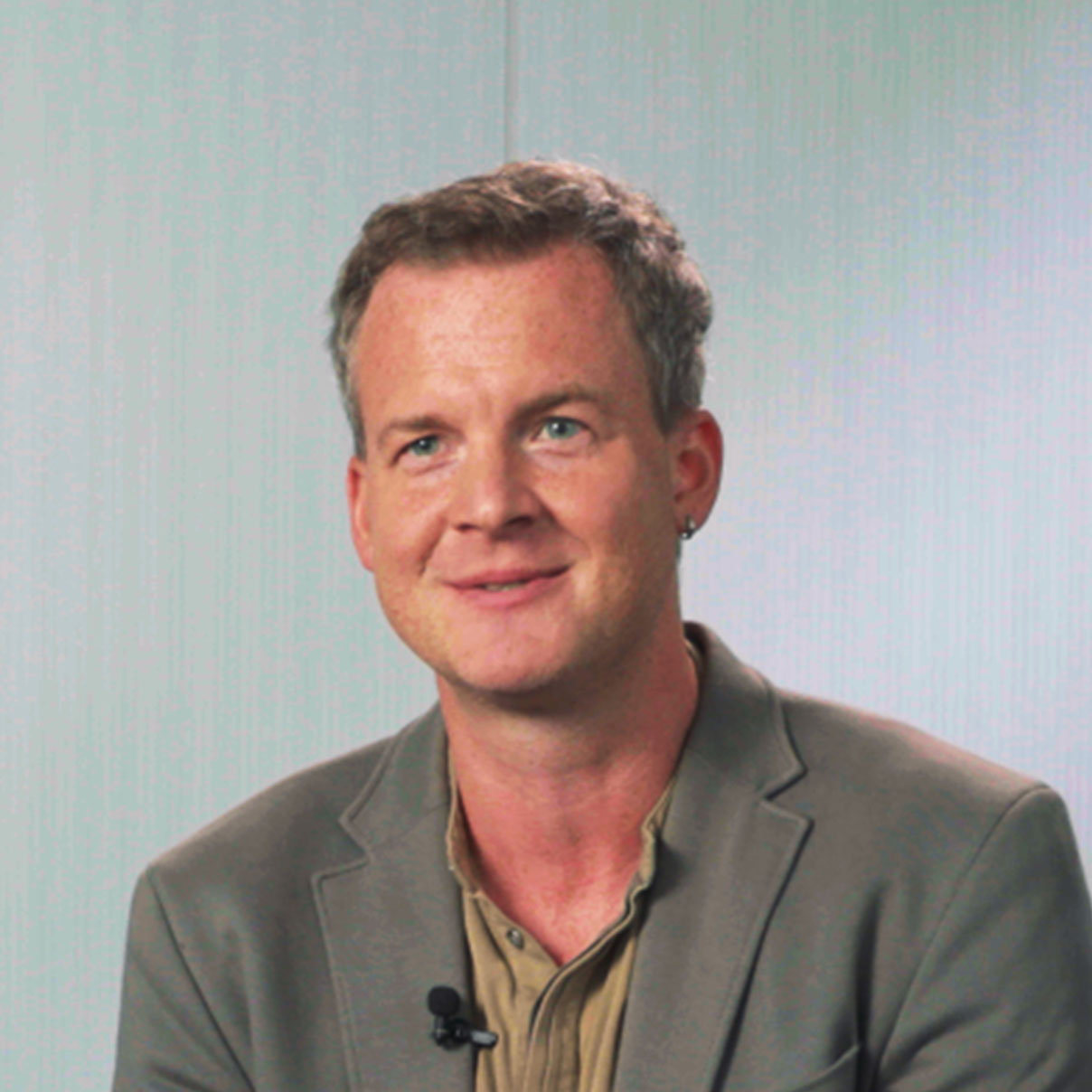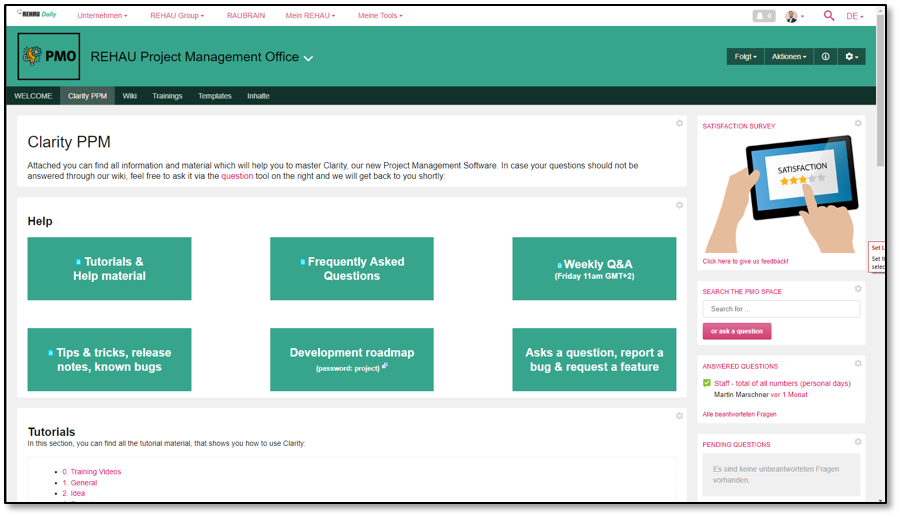Would you like to display the content of YouTube? Then please confirm this with one of the two buttons. Please note that data will be exchanged with a third-party provider.
More InformationAbout the Interviewee

Dr.-Ing. Uwe Kernchen, Head of Project Management Office
Dr. Uwe Kernchen has been head of the central PMO at REHAU since 2018. His duties at REHAU are to define and implement project management standards, and he also manages the project management tool Clarity and the trainings for it.
About REHAU Group
The REHAU Group unites five strong companies under one roof: Meraxis, New Ventures, RAUMEDIC, REHAU Automotive and REHAU Industries. With polymer-based solutions, the family-owned company generates annual sales of over 4 billion euros. More than 20,000 people work for the group of companies, which has grown independently over the course of a century.
Passionate and committed, employees at more than 190 sites develop, manufacture and market innovative products and solutions for the automotive, construction, furniture, materials, medical and industrial sectors with a common goal: to improve lives through the use of innovative, sustainable technologies.
- Polymer processor
- > 20,000 employees
- Located in Rehau, Germany
- Founded in 1948
- More than 190 locations worldwide
Experience Clarity Live!
We would be happy to demonstrate the features of Clarity to you in a live system. Let us know what you are particularly interested in, and then we can arrange our first web session together.

Interview in Text Format
Why We Needed New PPM Software
What challenges have you encountered that you needed PPM software to overcome?
Our earlier project management tool suffered from many acceptance problems, so that we never had a complete and transparent picture of our project portfolio. The old tool performed no more than a documentary function: uploading data, reporting the current status, and that was it. And, of course, Clarity represents a quantum leap forward from this.
We had to do something, because a clean project management tool is indispensable for corporate management. This was the big pain point that had to be solved by implementing Clarity and that the latter tool was finally able to address.
I don’t think it’s worth the effort to even try to see if Office solutions could be used for project management. If you rely on the Clarity tool from the very beginning, you start off on a professional footing, have access to everything in one place, and can save a tremendous amount of time, effort, and frustration.
Why did you choose Clarity?
We went searching on the market with a kind of wish list and compared the various tools. In the end, there were two final candidates that came closest to satisfying our requirements, and one of them was Clarity. We already had achieved a compliance level of over 80% with the standard, and so we decided in favor of this tool.
The huge advantage of working with Clarity as a project manager is that it provides you with everything in one tool. Everything that needs to be done in the area of project management is not only manageable, but also evaluable. It ultimately makes things more tractable as well as provides incredible relief for the project manager to have everything in one place.
Central Success Factors for the Software Implementation
What were the challenges during the implementation phase?
One challenge of the implementation was that we were carrying out the project during the Coronavirus pandemic. The entire project life cycle, from planning to implementation of Clarity to project completion, was therefore completely virtual. This stage went very well, because the team structures both at itdesign as well as here internally were such that everyone proactively participated. This can be seen just from the fact that we were able to carry out the implementation of Clarity in the planned timeframe.
In addition, we had to reconcile the varying structures and requirements of the different companies of the REHAU Group, especially REHAU Industries, and Meraxis. In the end, we also had to find out a way of mapping our sometimes complex internal structures with the new Clarity construct, so that we could ensure that the absolutely necessary features were in good working order.
What were the success factors for the implementation of the new tool?
The essential success factors for the introduction of a completely new tool are having a clear goal, good communication with a training at the end, sound project planning, specialist expertise, stringency, and having fun carrying out the project.
How did the Proof of Concept help you decide on the solution and proceed with the implementation?
We implemented Clarity in Clarity itself. This was the original project and was assigned project number P00001.
Before you can convince others of the worth of a new tool, you first have to be convinced of this yourself. In the course of implementing Clarity directly as our first project, we became sufficiently convinced of its merits, so that we were able to convince others afterwards with the same level of enthusiasm as true believers.
The methodology of a Proof of Concept is ultimately to ensure that you are not sold a bill of goods. However, it was important for us to ensure from the start and in a very early project phase that Clarity offered everything we needed.
itdesign was at our side during the implementation. This has also turned out to be a positive experience, because our colleagues at itdesign are very reliable, they know what they are talking about, and you can tell that they enjoy what they do every day.
How did you manage to implement Clarity at two companies at the same time?
The two sister companies REHAU Industries and Meraxis operate in two completely different areas. Of course, the two companies have a lot in common when it comes to project management, but there are also different aspects, approaches, and perspectives.
However, it turned out to be no problem at all for us to add Meraxis to the implementation project, because we were able to address the sometimes varying concerns without any problems by using the individual customization options of Clarity (e.g., blueprints and templates).
To what extent did the agile approach help you during implementation?
It made a lot of sense for us to break down the project goal into relatively small components, i.e., sprints or phases. This allowed us to start the implementation and processing in a topic-focused manner and not get lost in the big picture. In the end, this process helped us to launch very quickly with an initial installation of Clarity that was configured just the way we needed it.
You attached great importance to a well developed communication and training concept. How has this enriched your Clarity implementation?
In order to complete the implementation of Clarity, it was of course necessary to inform and train our internal colleagues accordingly.
We conducted this training in the form of two-hour presentations. These were supplemented by short training videos that we made in house, which explained the features of the tool in a focused manner. We distributed these internal training videos through our PMO Daily site, as we termed it, on our intranet.
Ultimately, we were also able to ensure a high level of acceptance of Clarity by holding weekly Q&A sessions in which colleagues could dial in with their problems, which we could then try to solve ad hoc.

What are some important experiences you had during the implementation phase?
Basically, we realized that things turned out to be much simpler than we would have expected from our own specifications, which was something new to us. Let me just mention the risk analysis by way of example: This risk management module in Clarity is very simple and intuitive to use. We wanted to map our old structure in the tool – a highly complex format. And this is where Clarity ultimately helped us to simplify our process.
In this way, Clarity and itdesign have also helped us to grow as a company and institute best practice approaches, influences, and suggestions from the outside world into our own company.
On the Everyday Added Value of Clarity
How is Clarity used in your company today?
It is our company’s must-have software for project management. So everything that presents itself as a project at REHAU Industries and Meraxis must be created in Clarity and documented and managed there.
This also includes topics such as risk analysis, issues and risk management, as well as transparency about finance, important key figures, and business cases. All these features are fundamentally made possible by the corresponding modules in Clarity.
What is the specific added value that Clarify provides for your company?
The comprehensive project management functions provide the biggest value for us. Everything is organized in one place. For me, Clarity means: Project management made easy.
Our colleagues are very happy to work with it, including not just the project managers, but also project staff. For them it offers real added value due to its full transparency and also due to the fact that it is an all-in-one tool. It also affords opportunities for collaboration, which ultimately helps the project team be more engaged and organize their work, especially in agile projects, since it helps with motivation and momentum.
To what extent is the topic of audit compliance and traceability for projects important to you?
Clarity supports audit compliance for projects in that all project management practices can be found in one place and are thus secure for revision.
It is important that projects are traceable, since it allows us to gain experience and make improvements on follow-up projects. But especially when it comes to critical product developments where there is a risk to life and limb, it must be possible to trace what project management tasks have been completed at all times. And Clarity has been a huge help in this regard.
Cost Savings and Data Security Due to Automatic Rights Assignment
How does the automatic assignment of rights work in your tool? What are the advantages of this customization in Clarity?
The automatic rights assignment in Clarity ensures that the relevant people are given all the roles that are relevant to performing their job. At the same time, this ensures that we do not give people extraneous permissions that they should not have.
Automatic rights assignment is faster and more reliable than if we had to assign extra people to perform this task manually. In addition, we can develop our license model in a focused and needs-based manner and keep the number of licenses within a certain framework. Ultimately, this translates to cost savings.
Resource & Scenario Planning with Helpful Add-ons
How do you use the add-ons itd Advanced Resource Planning and Meisterplan? What added value do they provide?
The overall structure of resource planning and resource management is supported by ARP (itd Advanced Resource Planning) in combination with Meisterplan.
itd Advanced Resource Planning is used for the actual planning, while Meisterplan is used for the “what if” scenario planning. These two tools harmonize and synchronize with each other. And so it is very helpful for our pilot department to see: What resources are available without overburdening our people? It’s really about sound planning: What resources do we have available and what projects can we implement with them?
Interfaces to Important Third-Party Systems
Which interfaces do you use, and what specific added value do they provide?
We use two main interfaces. Our interface to SAP allows us to upload incurred costs to Clarity on a daily basis. This gives the project manager the opportunity to compare the actual costs with the budgeted ones at any time.
And the second important interface is the one to our IAM*: This interface ensures that we can clearly define the different data protection requirements for internal and external employees and therefore avoid any conflicts with legal requirements.
*IAM = Identity & Access Management
Successful Cooperation With itdesign as a Partner
Why did you choose to partner with itdesign? What is the basis of the good partnership?
With itdesign as Broadcom’s premium partner, we naturally assumed that the project would be a success. And experience has proven that to be true. After the first introductory meeting and the Proof of Concept, it was clear that we definitely wanted to continue the implementation with you.
If we had to install Clarity all over again, we would gladly choose to do it with the itdesign team. It was definitely worth it, and we had fun, too. And the success that we have had is confirmation enough that we chose the right software, the right approach, and the right partner.
Read Next

Interview: Implementing Clarity at Bausparkasse Schwäbisch Hall




